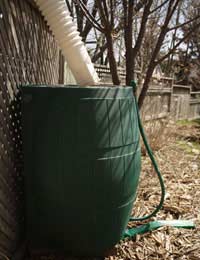 With water shortages becoming more common and a greater concern being shown for our natural resources many people are now looking at ways to use water more wisely, particularly in the garden.
With water shortages becoming more common and a greater concern being shown for our natural resources many people are now looking at ways to use water more wisely, particularly in the garden.
Many people now channel used or wastewater into their gardens and get a double usage from a resource that would be otherwise wasted.
There are a number of different ways of doing this.
Saving Rain is Like Money in the Bank.
One method is rainwater diversion. This is achieved by fitting special diverters to the down pipes of your storm water system. When it rains the water channelled off your roof is diverted at the down pipe into storage tanks. Once the tanks are full, the diverter then switches the run off back to your normal storm water system. The water held in the storage tanks is used to water your gardens. The only major problem with this system is that if you happen to live in a largely populated or industrial town a lot of airborne pollution is often washed down with the first flush of rain. Another problem is to avoid having open containers, as these can become an ideal breeding ground for mosquitoes. Always ensure your containers have tight fitting lids and the lids are kept fitted.
Using Water Twice.
Another good water source for your garden is what is referred to as “Grey Water”. Grey water is water from your bathtub, washbasin, and washing machine. Water from areas like your kitchen sink and dishwasher are referred to as “Brown Water”, which is unsuitable for garden use due to the health hazard it poses.
Any water that contains food particles or faecal matter should be avoided as it can transfer bacteria and diseases to you as you transport and utilize it. This includes any washing machine water used to clean cloth nappies.
Check with your local council on their policies regarding grey water. This is particularly important if you intent to make any plumbing modifications to accommodate your grey water system.
The Family Bucket Brigade.
The best method to transport grey water to your garden is by using buckets. Ensure those buckets are kept specifically for that purpose alone.
Once you have finished your bath, let the water cool and empty the bath by bucket, taking the water to where it is needed in the garden. Surprisingly this can be a most enjoyable and fun family activity and your plants will love you for it.
From Clean Clothes to Healthy Plants.
If you intent to use washing machine water on the garden, change to an environmentally safe washing powder. Run the outlet hose into a large drum. This drum should be set lower than your washing machine to reduce the strain on the machines pump. Install a tap on the bottom of the drum to drain the water off. Allow the drum to fill, particularly if you wash in hot water as it allows it to cool. Once it is practically full start taking buckets of water from it and distribute it around the garden. When you are watering, try to dampen only the soil not the leaves of the plants. If you water the soil any bacteria in the water is broken down and the nutrients in the water reach where they are meant to go.
Especially avoid splashing water on leaves of vegetables such as Lettuce, Silver Beet and cabbage, in fact any vegetables that you will eat the leaves of, as this too can pass on harmful bacteria and disease.
Once you have finished wash the drum out thoroughly as any grey water remaining will quickly smell and become a breeding ground for bacteria causing a health hazard.
You will notice a difference in your plants as they attain the nutrients from the grey water that would generally be lost. You also get the benefit of saving on water, especially if your water usage is metered or there are water restrictions.
Water is one of this planets greatest resources and if you recycle it safely, water that is now wasted can find its way towards keeping your garden green and healthy throughout the hottest weather.




I want know the garening water specification like PH value & Hardness level to be maintain. Regards, V.DHANDAPANI